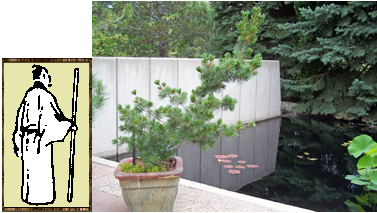
Hexagram Fifty-five—Abundance
Hexagram Fifty-five signifies influence. In this image, one's influence is at its height, like the full moon, or the sun when it reaches the mid-way point in the sky. Celebrate now, for influence waxes and wanes in natural cycles.
The first line, yang, shows a powerful person meeting with a colleague. They regard each other as equals and applaud each others' successes. It is good to go forward.
The second line, yin, shows one who can see the stars in the daylight. Disclosing this unusual power will lead to suspicion. It is better to maintain honest and true purpose. Gradually find ways use this power for good.
The third line, yang, explains that one who can see the stars in daylight is showered with abundance. Remain calm in this situation; accept what comes in a mood of humility and gratitude. Trying to do additional good works at this time could bring trouble.
The fourth line, yang, shows that one who can see stars in daylight may feel out of place in society. It is a good time to seek an enlightened master or meet with honorable friends, like the colleagues in the first line.
The fifth line, yin, shows celebration and praise for work well done. The subject surrounds themself with qualified people, for they will recognize the subject's accomplishments.
The sixth line, yin, shows a house that is too large. No one comes to visit, which is unfortunate. It is better to be humble. Friends are more important than money.
Hexagram Fifty-five Commentary
This hexagram discusses abundance and influence. The introduction explains when one's influence is high, it's like the full moon, or mid-day sun. The subject cherishes the times when his or her influence is at its peak, but realizes it will wax and wane in natural cycles—not just increase.
The first line, yang, shows an influential person meeting another influential person, a colleague. They regard each other as equals, and congratulate each others' success. This is a good meeting and firm basis for moving forward.
The second line, yin, shows a person who can see the stars in the daytime. This is an odd power, so disclosing it might make people suspicious. However, it's an essential power working within to bring an inner vision into reality. Instead of talking about it, keep the vision alive inside and keep working on it.
The third line, yang, elaborates on the powers of the person in the previous line. It says seeing the stars in the daylight is a vision that will bring about miracles. A person who experiences this mystical connection needs to remain calm and immersed in gratitude. Moving forward too quickly with unformed ideas may invite trouble.
The fourth line, yang, elaborates further. It says a person who sees stars in the daytime may begin to feel alienated from society. The line recommends finding a teacher who is enlightened, who can offer support and direction. Another solution is to meet with honorable colleagues, like the people in the first line. Other people following their vision will be able to help.
The fifth line, yin, shows the vision turning into reality. It's a time to celebrate and accept praise for work well done. The advice to the subject is to surround themself with colleagues who can recognize their accomplishments.
The sixty line, yin, explains how important it is for the subject to remain humble and hang onto old friends, even after achieve the subject achieves their dreams. The metaphor is to avoid a house that is too large, where nobody will come to visit you.
To the reader: Most of the hexagrams have at least one line that predicts bad results, but that does NOT mean you are fated to that result. The hexagrams illustrate different attitudes, so study the actions and reactions to learn the attitudes that will lead to better outcomes.
The I Ching teaches you to flow with changes and create positive change from the inside through conscious living. Your future is in your hands. Consult the I Ching for ideas that lead to clear thinking and positive mental attitude. Reading the I Ching helps you take the time to reflect on your attitudes and ideas. Continue asking until you feel positive about your course.

Click here for another hexagram.
A note about this interpretation of the I Ching: Nori Muster wrote this version of the I Ching in 1994 and put it online at Surrealist.org in 2000. It is also available at Amazon:
e-book
paperback
